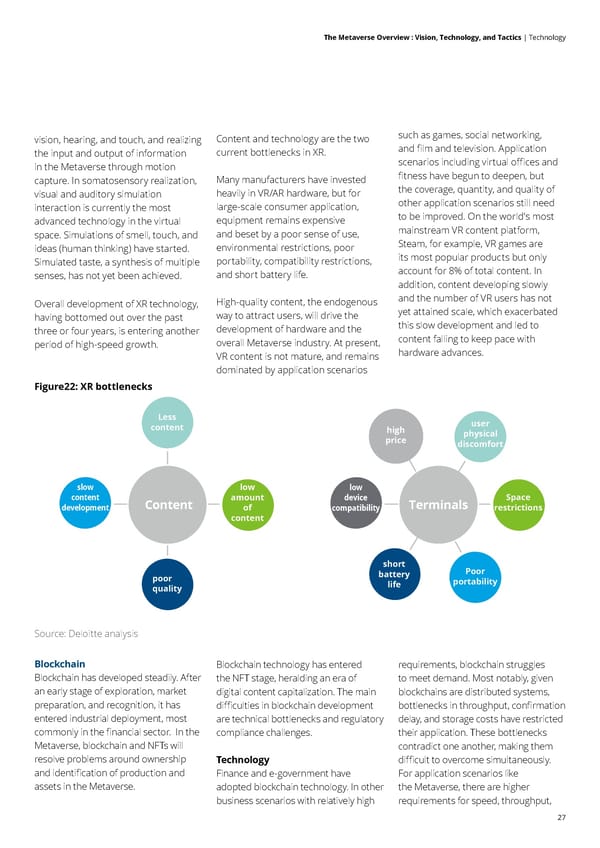27 The Metaverse Overview : Vision, Technology, and Tactics | Technology Blockchain Blockchain has developed steadily. After an early stage of exploration, market preparation, and recognition, it has entered industrial deployment, most commonly in the financial sector. In the Metaverse, blockchain and NFTs will resolve problems around ownership and identification of production and assets in the Metaverse. Blockchain technology has entered the NFT stage, heralding an era of digital content capitalization. The main difficulties in blockchain development are technical bottlenecks and regulatory compliance challenges. Technology Finance and e-government have adopted blockchain technology. In other business scenarios with relatively high requirements, blockchain struggles to meet demand. Most notably, given blockchains are distributed systems, bottlenecks in throughput, confirmation delay, and storage costs have restricted their application. These bottlenecks contradict one another, making them difficult to overcome simultaneously. For application scenarios like the Metaverse, there are higher requirements for speed, throughput, Figure22: XR bottlenecks Source: Deloitte analysis vision, hearing, and touch, and realizing the input and output of information in the Metaverse through motion capture. In somatosensory realization, visual and auditory simulation interaction is currently the most advanced technology in the virtual space. Simulations of smell, touch, and ideas (human thinking) have started. Simulated taste, a synthesis of multiple senses, has not yet been achieved. Overall development of XR technology, having bottomed out over the past three or four years, is entering another period of high-speed growth. Content and technology are the two current bottlenecks in XR. Many manufacturers have invested heavily in VR/AR hardware, but for large-scale consumer application, equipment remains expensive and beset by a poor sense of use, environmental restrictions, poor portability, compatibility restrictions, and short battery life. High-quality content, the endogenous way to attract users, will drive the development of hardware and the overall Metaverse industry. At present, VR content is not mature, and remains dominated by application scenarios such as games, social networking, and film and television. Application scenarios including virtual offices and fitness have begun to deepen, but the coverage, quantity, and quality of other application scenarios still need to be improved. On the world's most mainstream VR content platform, Steam, for example, VR games are its most popular products but only account for 8% of total content. In addition, content developing slowly and the number of VR users has not yet attained scale, which exacerbated this slow development and led to content falling to keep pace with hardware advances. Content Less content low amount of content poor quality slow content development Terminals user physical discomfort high price Poor portability short battery life low device compatibility Space restrictions
 Deloitte The Metaverse Overview Page 26 Page 28
Deloitte The Metaverse Overview Page 26 Page 28